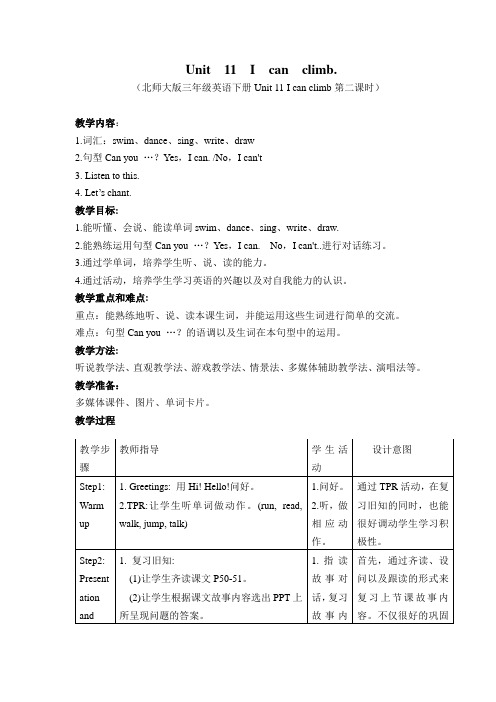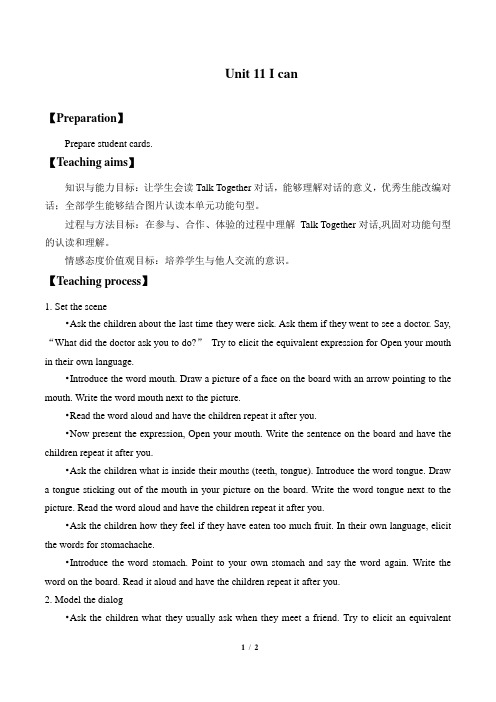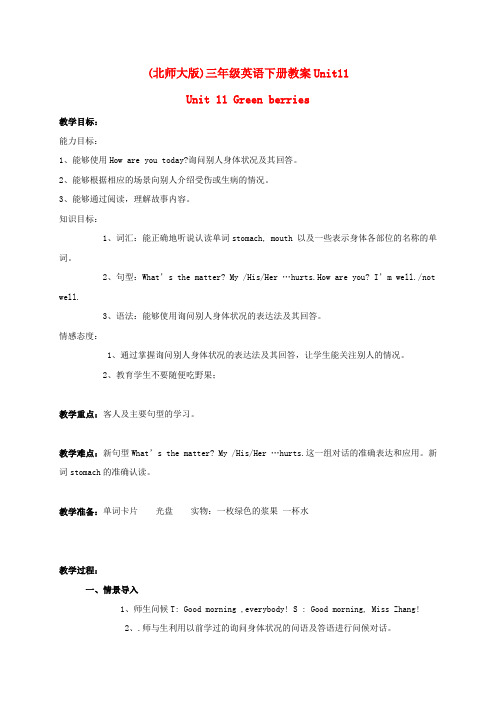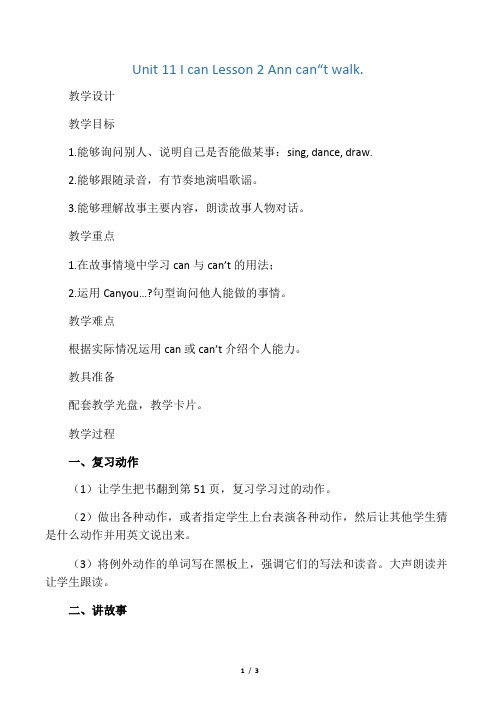北师大(三起)三年级英语下册unit 11 i can lesson 2 ann can't walk课后练习题2
- 格式:doc
- 大小:687.59 KB
- 文档页数:2

Unit 11 I can climb.(北师大版三年级英语下册Unit 11 I can climb第二课时)教学内容:1.词汇:swim、dance、sing、write、draw2.句型Can you …?Yes,I can. /No,I can't3. Listen to this.4. Let’s chant.教学目标:1.能听懂、会说、能读单词swim、dance、sing、write、draw.2.能熟练运用句型Can you …?Yes,I can. No,I can't..进行对话练习。
3.通过学单词,培养学生听、说、读的能力。
4.通过活动,培养学生学习英语的兴趣以及对自我能力的认识。
教学重点和难点:重点:能熟练地听、说、读本课生词,并能运用这些生词进行简单的交流。
难点:句型Can you …?的语调以及生词在本句型中的运用。
教学方法:听说教学法、直观教学法、游戏教学法、情景法、多媒体辅助教学法、演唱法等。
教学准备:多媒体课件、图片、单词卡片。
教学过程Bb Design:Unit 11 I can climbI can …Can you … ?Yes, I can. / No, I can ’t.Unit 11 I can climb 教学反思本节课的教学重点是能听懂、会说、能读单词run 、swim 、read 、jump 、dance 、sing 、write 、talk 、draw ,并能用can you..?句型进行交际。
在本课的实际教学中,我较好地完成了本课的教学目标和教学内容,完成了教案中所设计的各项活动和任务。
依据“新课标”的要求,我在本课的教学中运用体验、实践、参与、合作与交流为主导的学习方式,把整个教学程序设计为热身复习——新知体验——趣味操练——巩固练习。
在实际教学中,我真实地感受到孩子们的轻松与快乐。
语言学习对孩子们来说不再是死记硬背的煎熬,而是多种多样的有趣的活动参与和丰富的学习体验。

Unit 11 I can【Preparation】Prepare student cards.【Teaching aims】知识与能力目标:让学生会读Talk Together 对话,能够理解对话的意义,优秀生能改编对话;全部学生能够结合图片认读本单元功能句型。
过程与方法目标:在参与、合作、体验的过程中理解Talk Together 对话,巩固对功能句型的认读和理解。
情感态度价值观目标:培养学生与他人交流的意识。
【Teaching process】1. Set the scene•Ask the children about the last time they were sick. Ask them if they went to see a doctor. Say, “What did the doctor ask you to do?”Try to elicit the equivalent expression for Open your mouth in their own language.•Introduce the word mouth. Draw a picture of a face on the board with an arrow pointing to the mouth. Write the word mouth next to the picture.•Read the word aloud and have the children repeat it after you.•Now present the expression, Open your mouth. Write the sentence on the board and have the children repeat it after you.•Ask the children what is inside their mouths (teeth, tongue). Introduce the word tongue. Draw a tongue sticking out of the mouth in your picture on the board. Write the word tongue next to the picture. Read the word aloud and have the children repeat it after you.•Ask the children how they feel if they have eaten too much fruit. In their own language, elicit the words for stomachache.•Introduce the word stomach. Point to your own stomach and say the word again. Write the word on the board. Read it aloud and have the children repeat it after you.2. Model the dialog•Ask the children what they usually ask when they meet a friend. Try to elicit an equivalentexpression for “How are you”?•Say, “In English we use the expression, How are you?”•Write the question on the board. Have the children repeat it after you.•Now present the sentence, I’m not well. Explain its meaning to the children.•Write the sentence on the board and then have the children repeat the words after you.•Repeat the procedure for My stomach hurts.•Now explain that when someone who has been sick has recovered, in English they often say, I’m better. Model the structure, write it on the board, and have the children repeat it after you.3. Talk about the story1 Have the children open their books. Ask these questions about the pictures:Picture 1: “What is Ken doing?”Pictures 2/3:“What do you think Mocky/Ken is saying?”Pictures 4/5: “What is happening now?”Pictures 6/7: “What do you think Uncle Booky /Ke n is saying?”Picture 8: “What do you think Uncle Booky is giving Ken?”Picture 9: “Does Ken like the taste?”Picture 10:“How is Ken feeling now?”4. Story Student Book•Say, “Now we will hear what the characters said.”Play the tape and have the children look at the pictures as they listen•Play the tape again, pausing after each picture. Have the children repeat the words each time.•Explain the meaning of the expressions Come with me (Picture 4), Say “aaaah” .(Picture 7), and Drink this (Picture 8). Also explain the meaning of the words help and today. Write the words on the board and have the children repeat them after you.5. Set homeworkEncourage the children to tell the story to their families.。


Unit 11 I canLesson 6 Round up一、教材分析:本课是北师大版英语教材三年级下册Unit 11 I Can的第六课时,为复习及故事拓展教学,教学活动围绕本单元的主题“我能”展开,侧重于运用前几个课时中所学的表示活动或动作的动词,进行个人、他人或动物能力的说明与介绍。
在此学习过程中,通过教师引导,有利于学生认识、发展个人能力,提升自我意识,对学生从小就树立良好的、健康的自我认识具有积极作用。
二、学情分析:本课的教学对象是三年级的学生,通过半年的英语学习,能听懂简单的英语指令,在故事学习中具备了一定的观察、思考、想象和推测的能力,能在图片的帮助下理解故事内容。
三年级的学生是英语学习兴趣最浓厚的时期,喜欢运用自己新学的英语进行表达,并且不怕出错。
但由于年龄特点,上课注意力容易分散,不易持久保持,需要丰富多彩的教学活动充分保持他们的学习热情。
三、教学目标:1、知识目标:(1)能尝试使用句子:What can ... do? 询问自己或他人能做什么,并能正确使用I/You/He/She/It can ...这一句型表达自己或他人能做的事;(2)能熟练使用句子Can you/ he/ she/ it ...?询问他人,并能正确回答。
(3)能根据故事内容理解、认读情境词join。
2、技能目标:(1)能介绍自己能做的事,询问和介绍他人能做的事;(2)能理解故事主要内容,并朗读故事人物对话。
(3)能独立完成练习。
3、情感目标:(1)培养学生良好的、健康的自我认识,并认识学习的作用,主动发掘个人潜力。
(2)激发学生主动了解周围同学,并用英语进行表达的意识。
四、教学重、难点:重点:能理解故事内容,并能够正确朗读故事。
难点:能正确进行人称代词的转换。
五、教具准备:课本,多媒体课件,视频,单词卡,句型卡,磁扣,彩色粉笔。
六、教学过程Step 1: Warming up1. Greeting.2.Sing the first section of the song "I can". Then have them join me to sing this song. (Stick the word card of "sing", "join" on the blackboard.)3. Sing the song and do the actionsStep 2 Review1.Point to the robot and ask: What can he do? (Stick the word card on the blackboard when they mention it.)2.PPT shows a boy whose finger hurts and ask: Can he draw?He can't ____, too.3.PPT shows another little boy who holding the book upside down and ask:Can he read? Why? Then explain the reason: Because he i s only a little boy. PPT shows a picture of little cat, h ave them try to describe it: It's a ____ cat.4.Have them turn to page 60 and finish practice 2 by th emselves.5.Have them discuss with their partners, explain the reaso ns why they choose that answer. Then check the answers toge ther. (Stick the word cards of "speak" and "climb".)6.Introduce myself: I can sing, jump…Then ask them:What can you do?(Write the key sentences on the blackboard.)Step 3: Reading1.T: You know what you can do. But a little turtle does n’t know. Look! (PPT shows pictureLet’s watch and listen. Then answer his question:What can I do?2. Play CAI. Then check the answer.3. Ask two questions in advance:①What other animals are there in the story?②What can they do?Play CAI. Have them listen and repeat.4. Have them turn to page 61 and discuss about question 1 with their partners. Then check the answers together.(Stick the animal picture card on the blackboard when th ey mention it.)5. Have them answer question 2, then listen and repeat. (Re move the word cards according to their answers.)6. Have them guess the meaning of "join" according to the context.7. Play the tape. Have them listen and repeat by roles. Step 4: Post Reading1.Grouping. Have them act out the story by roles together .2. T: The little can't sing, climb, dance and jump. But h e can swim. But he is happy. Because:No one can do everything.3.T: I can't swim and climb.But I can jump and run.This is me.How about you?Step 5 Watch the video(视情况选用)1. T:If we can't do something. We can learn.2. Make a brief introduction about Nick Vujicic.3. Play the video. Ask: What can he do?4. Summarize: He can.All people can.If you learn, you can!Step 6: Set Homework(视情况选其1)A: 1. Read the story.2. Interview your parents: What can you do?B: 1. Tell the story of Nick to your parents.2. Talk about your feelings.七、板书设计:Unit 11 I canWhat can you do?I can ____.sing jump swim dance walk run draw write join little read speak climb ↓Unit 11 I canWhat can I do?You can swim.singclimbdancejumpswim walk run draw write joinlittle read speak。

(北师大版)三年级英语下册教案Unit11Unit 11 Green berries教学目标:能力目标:1、能够使用How are you today?询问别人身体状况及其回答。
2、能够根据相应的场景向别人介绍受伤或生病的情况。
3、能够通过阅读,理解故事内容。
知识目标:1、词汇:能正确地听说认读单词stomach, mouth 以及一些表示身体各部位的名称的单词。
2、句型:What’s the matter? My /His/Her …hurts.How are you? I’m well./not well.3、语法:能够使用询问别人身体状况的表达法及其回答。
情感态度:1、通过掌握询问别人身体状况的表达法及其回答,让学生能关注别人的情况。
2、教育学生不要随便吃野果;教学重点:客人及主要句型的学习。
教学难点:新句型What’s the matter? My /His/Her …hurts.这一组对话的准确表达和应用。
新词stomach的准确认读。
教学准备:单词卡片光盘实物:一枚绿色的浆果一杯水教学过程:一、情景导入1、师生问候T: Good morning ,everybody! S : Good morning, Miss Zhang!2、.师与生利用以前学过的询问身体状况的问语及答语进行问候对话。
T: Hello, Peter. How are you? S: I’m fine,thank you.依次询问几位同学。
3、引出新句型。
(1)Who can ask me? (Hello,Miss Zhang. How are you?)(2)S: Hello,Miss Zhang. How are you? T: I’m well.(板书)(3)理解单词well.用单词卡片(做身体健康样子的动作)并进行对话操练。
(4)T: Oh ,today is really hot(师做热的样子) I’m thirsty. I want to drink something.师扮成喝完水后肚子疼的样子。

Unit 11 I can Lesson 2 Ann can“t walk.教学设计教学目标1.能够询问别人、说明自己是否能做某事:sing, dance, draw.2.能够跟随录音,有节奏地演唱歌谣。
3.能够理解故事主要内容,朗读故事人物对话。
教学重点1.在故事情境中学习can与can’t的用法;2.运用Canyou…?句型询问他人能做的事情。
教学难点根据实际情况运用can或can’t介绍个人能力。
教具准备配套教学光盘,教学卡片。
教学过程一、复习动作(1)让学生把书翻到第51页,复习学习过的动作。
(2)做出各种动作,或者指定学生上台表演各种动作,然后让其他学生猜是什么动作并用英文说出来。
(3)将例外动作的单词写在黑板上,强调它们的写法和读音。
大声朗读并让学生跟读。
二、讲故事让学生把书翻到52页,根据图片提问下列问题。
教师可尝试用英语提问。
如果学生理解有困难,再改用汉语提问:图片6:Ann怎么了?(She fell down.)图片7:Ann还可以走路?(No, she can’t.)图片8:Uncle Booky怎么询问Ann的伤势的?(What’s the matter?)图片9:Uncle Booky能帮助Ann吗?(Yes, he can.)图片10:Ann不能走路了,但是她可以干什么?(She can listen.)三、听故事让学生把书翻到第52页。
(1)对学生说:“我们现在听听这些人物都说了什么。
”(2)统统地放一遍录音。
(3)再放一遍录音,每幅图后暂停,让学生重复每句话。
(4)把全班分为两组,一组扮演Ann,一组扮演Ken,老师扮演Uncle Booky.(5)再次放录音。
每次放一句话,让每组重复相应人物所说的话。
然后两组交换角色。
四、一起说(1)让学生把书翻到第53页,看看小男孩和小女孩在做什么。
(2)让学生看插图,说一说小男孩会什么,小女孩会什么。
(3)学生分成小组扮演小男孩和小女孩,练习对话。
Unit 11 I can Lesson 2 Ann can't walk.同步练习一、将单词与图片连线。
1. draw2. climb a tree3. carry4. listen to music5. dance6. write二、从Ⅱ栏中选出Ⅰ栏的正确答语。
ⅠⅡ( )1. What can you do? A. It’s a rooster.( )2. What’s this? B. I can sing·( )3. Can you see a red ruler? C. No,it isn’t.( )4. Is this a rat? D. Yes,there are.( )5. Are there trees? E. Yes,I can.( )6. How are you? F. There are three.( )7. What color is it? G. I'm fine.( )8. How many rooms? H. It's orange.三、看图,你知道这些动物会干什么吗?请写下来。
1. 2. 3.4. 5. 6.四、读一读,将句子与图片连线。
1.——What can you do? A.——I can draw.2.——What can they do?——They can walk. B.3.——Can they swim?——Yes, they can. C.4.——Can she dance? D.——Yes, she can.5.——What can she do? E.——She can play Erhu.五、看对话,给以下图片排序。
1. He can jump.2. This is a bird.3. The house is beautiful.4. I can see a tree.5. He can swim.6. There are flowers.( ) ( ) ( ) ( ) ( ) ( )参考答案一、1. draw 2. climb a tree 3. carry 4. listen to music 5. dance 6. write二、1~4 B A E C 5~8 D G H F三、1. walk 2. jump 3. fly 4. climb 5. swim 6. run四、1~5 BCEAD五、3 4 1 6 2 5。
Unit 11 I canLesson 1 I can climb教案教学目标知识目标:(1)能用“ I can … .”描述简单的动作。
(2)能用“Can you … ?/ Yes, I can./ No, I can’t.”在情景中进行简单的交际。
能力目标:(1)培养学生标准、流畅的语音、语调。
(2)培养学生合作学习的能力,充分发挥孩子们的自主性,在游戏活动中最大程度的调动孩子们的学习积极性。
(3)培养学生的语言交际能力和用英语思考的能力。
情感目标:(1)运用积极的评价,亲切的语言,营造宽松、民主、和谐的英语学习氛围。
(2)运用丰富多彩的课堂教学活动,使孩子们体验到学习的乐趣。
(3)使孩子们在说英语、用英语的过程中不断体验成功,进一步激发学习的兴趣。
(4)在活动中培养孩子们的观察和总结能力,同时也使他们更加热爱小动物。
教学重点尽量拓展本句型应用的广度与深度,使孩子们形成用英语表达、用英语思维的习惯。
因此,教师首先利用唱歌谣、抛球游戏引入句型教学,而在句型练习时又不止局限于书本上的知识,还拓展到利用动物的本能差异来诱导孩子学会用这个句型表达各种各样的意思;在此同时充分运用多媒体教学手段,激发学生的学习兴趣;最后在孩子理解句型的基础上又添加游戏环节,让学生在玩乐当中进一步巩固及拓展句型,使课堂变得更加生动、有趣,也使孩子们把当日所学内容与旧知联系起来,同时更能引导孩子们自己整合所学知识自编对话。
教学难点1. 对孩子进行准确、流畅的英语语音、语调的训练和培养。
2. 培养孩子们的语言运用能力。
3.教师旨在进行“I can…can you? Yes, I can. No, I can’t.” 的教学。
教学过程一、Greeting (通过师生问候,营造欢乐的英语学习氛围)T:Good morning , boys and girls.Nice to see you.Ss: Nice to see you , too.T: Are you happy today? If you’re happy,let’t chant,OK ?二、Warm up(选择学生喜爱的唱歌谣形式开始一节愉快的英语课,通过热身运动,复习所学旧单词,为学习新知识作好铺垫)Have the students stand up and chant with actions.( An elephant can walk, walk, walk,walk…)三、Presentation1、T: I can walk.I can run. I can jump. What can you do ?(边说边做动作) (用抛球的方式引出本课句型。
Unit 11 I can Lesson 2 Ann can't walk.
同步练习
一、看图判断句子的正(T)误(F)。
( )1. I can’t walk.
( )2. He can dance.
( )3. She can play football.
二、情景选择。
( )1.上体育课的时候,小明摔倒在地,你关心他怎么了,你会问:
A. What can you do?
B. What’s the matter?
C. What color is it? ( )2.小明的脚摔伤了,走不了,他会说:
A. I can’t swim.
B. I can walk.
C. I can’t walk. ( )3.你想叫大家一起唱歌,你会说:
A. Let’s sing.
B. Let’s dance.
C. Let’s run.
三、下列单词排错了队,你会把他们重新排一排吗?
1. Matter, what’s, the(?)
2. You, see, can, house, our( ? )
3. Ball, catch, he, can’t, the(.)
四、请你找出不属于同类的单词,把序号写在括号里。
( )1. A. apple B. banana C. carry
( )2. A. swim B. shirt C. dress
( )3. A. blue B. catch C. white
( )4. A. climb B. cabbages C. carrots
( )5. A. chair B. run C. desk
五、根据图片,写出英文单词。
1. 2. 3.
4. 5. 6.
参考答案
一、1~3 T F F
二、1~3 B C A
三、1. What’s the matter? 2. Can you see our house? 3. He can’t catch the ball.
四、1~5 C A B A B
五、1. carry 2. draw 3. climb 4. dance 5. write 6. listen。